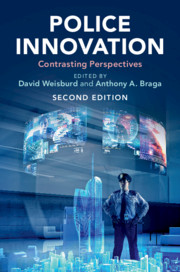Book contents
- Police Innovation
- Police Innovation
- Copyright page
- Contents
- Figures
- Tables
- Notes on Contributors
- Introduction
- Part I Community Policing
- Part II Procedural Justice Policing
- 3 Advocate
- 4 Critic
- Part III Broken Windows Policing
- Part IV Problem–Oriented Policing
- Part V Pulling Levers (Focused Deterrence) Policing
- Part VI Third–Party Policing
- Part VII Hot Spots Policing
- Part VIII Predictive Policing
- Part IX CompStat
- Part X Evidence-Based/ Risk-Focused Policing
- Part XI Technology Policing
- Index
- References
4 - Critic
The Limits of Procedural Justice
from Part II - Procedural Justice Policing
Published online by Cambridge University Press: 09 August 2019
- Police Innovation
- Police Innovation
- Copyright page
- Contents
- Figures
- Tables
- Notes on Contributors
- Introduction
- Part I Community Policing
- Part II Procedural Justice Policing
- 3 Advocate
- 4 Critic
- Part III Broken Windows Policing
- Part IV Problem–Oriented Policing
- Part V Pulling Levers (Focused Deterrence) Policing
- Part VI Third–Party Policing
- Part VII Hot Spots Policing
- Part VIII Predictive Policing
- Part IX CompStat
- Part X Evidence-Based/ Risk-Focused Policing
- Part XI Technology Policing
- Index
- References
Summary
Police are society’s last resort. We grant them broad authority to force solutions on urgent problems when less coercive tactics have failed. We always hope they will be able to resolve those problems peacefully; the whole point of concentrating the authority to use force in a single institution is to professionalize it – to ensure that it will be used less intensively and more responsibly than it otherwise would be (Bittner, 1990: 257ff.). But even when police successfully resolve an emergency without resorting to overt coercion, the covert threat of doing so if “voluntary” compliance fails always lies in the background.
- Type
- Chapter
- Information
- Police InnovationContrasting Perspectives, pp. 95 - 118Publisher: Cambridge University PressPrint publication year: 2019
References
- 10
- Cited by



